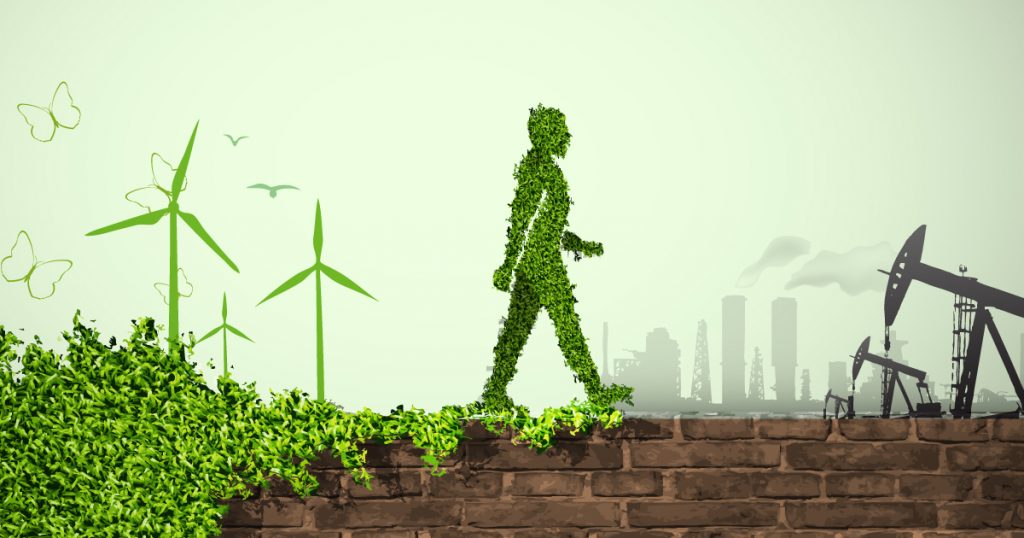Sustainability – the ability to be maintained at a certain rate or level.
Environmental Sustainability – the responsibly to conserve natural resources and protect global ecosystems to support health and well-being, now and in the future.

Environmental Sustainability
Every year across the world, on April 22, Earth Day is a time to bring people together to focus on a common goal: sustainability. However, to achieve this goal, sustainability must be at the forefront of everyday living and not just thought of once a year. Human well-being is closely linked to the health of the environment. Around the world, 24% of deaths can be traced back to avoidable environmental factors, according to the latest research. People need clean air to breathe, fresh water to drink, and places to live that are free of toxic substances and hazards. To achieve this, businesses, governments, and citizens must unite to create a partnership for the benefit and betterment of the planet. As we begin to experience the long-term consequences of exponential industrial growth and energy use, we must act to reverse these effects and prevent further damage, ensuring we have healthy places to live for generations to come. For businesses, it means committing to environmentally sustainable practices to help build thriving communities and secure future growth potential.

What is Environmental Sustainability?
Environmental sustainability is responsibly interacting with the planet to maintain natural resources and avoid jeopardizing the ability of future generations to meet their needs. Because so many decisions that impact the environment are not felt immediately, a key element of environmental sustainability is its forward-looking nature. In fact, the U.S. Environmental Protection Agency defines it as “meeting today’s needs without compromising the ability of future generations to meet their needs.” And according to the United Nations World Commission on Environment and Development, environmental sustainability is about acting in a way that ensures future generations have the natural resources available to live an equal, if not better, way of life as current generations. A walk on the beach or a hike in the woods reminds us that our forests, coral reefs, and even our deserts act as examples of sustainable systems. Sustainability is based on a simple principal: everything that we need for our survival and well-being depends, either directly or indirectly, on our natural environment. To pursue sustainability is to create and maintain the conditions under which humans and nature can exist in productive harmony to support present and future generations.

Why is Environmental Sustainability Important?
Environmental sustainability is important to preserve resources like clean air, water, and wildlife for future generations. It is also important because of how much energy, food, and human-made resources we use every day. Rapid population growth has resulted in increased farming and manufacturing of needed materials, leading to more greenhouse gas emissions, unsustainable energy use, and deforestation. It is vital that we all understand there must be a balance between the natural resources available to us and the human consumption of those resources. For renewable resources like crops and timber, the rate of harvest shouldn’t exceed the rate of regeneration. This is known as “sustainable yield”. For non-renewable resources like fossil fuels, the rate of depletion shouldn’t exceed the rate of development of renewable alternatives like solar or wind power. And for pollution, the rates of waste generation shouldn’t exceed the capacity of the environment to assimilate that waste. This is known as “sustainable waste disposal”. Achieving a balance between natural resources and human consumption that is both respectful of the natural world yet fuels our modern way of life, is one of the most important pieces in the climate-change puzzle. With unchecked resource depletion, we risk a global food crisis, an energy crisis, and an increase in greenhouse gas emissions that will lead to a global warming crisis. On the other hand, with too many restrictions on the use of natural resources, we risk slowing technological and economic advancement. For the future of our planet and the humans who populate it, it’s vial to weigh the competing needs of environmental protection and human development so both the natural world and society are able to flourish. By sharing best practices to ensure the greatest environmental, economic, and social impact, we can work together to make the most balanced environmental decisions for all concerned. Striking this delicate balance is challenging – though not impossible – and issues surrounding sustainability, the environment, and society have been the focus of scientists, philosophers, politicians, and policy experts for decades. Our planet can only provide so many resources before they begin to deplete. For this reason, businesses must step in and do their part. They have more power than any group of individuals, and they can help secure a livable future by investing in sustainable and responsible practices like reducing waste, using commercial clean energy, and recycling as much as possible. One thing is clear this is a balance we all must share and agree on because environmental sustainability is a vital part of our human survival on this planet.

Environmental Regulations
Standards for environmental sustainability vary greatly, based on local economic, social, and environmental conditions. Regulations are often set at the federal level. For example, the U.S. Environmental Protection Agency regulates everything from air pollutants to refrigerants to hazardous waste management. The EPA sets standards for the quality of air, water, soil, wildlife habitats, and carbon emissions, and enforces these standards with monetary penalties and legal action. State/provincial and local governments may also create more stringent guidelines. For example, cities like Madrid and Paris are beginning to set limits on diesel vehicles and older, less fuel-efficient models of cars. Since ecological conditions and economic and social systems differ from country to country, there is no single blueprint for how sustainability practices are to be carried out. Each country must work on its own concrete policy to ensure that sustainable development is carried out as a global objective. However, research indicates a broader, global set of regulations or a greater commitment from businesses themselves may be necessary to achieve environmental sustainability. A study featured in ‘Harvard Business Review’ shows multinational companies do effectively limit emissions where environmental regulations are strict but may emit more in countries with more lenient guidelines. In the U.S., the EPA is responsible for setting and enforcing regulations that involve environmental sustainability and protection which specifically cover:
- Air Quality
- Water Quality
- Soil Quality
- Plant Life
- Animals and Wildlife habitats
- Hazardous Waste
- Greenhouse Gas Emissions
Environmental law violations are considered white-collar crimes, with violators facing the possibility of fines, jail time, probation, or a combination of these. Most corporations, however, generally only incur fines for violations. In order to deter businesses from going outside the guidelines set, the guidelines must be clear, and the penalties must be such that it would benefit the business to comply. Only then will we see a uniform change in compliance across the board.

Economic Growth and Environmental Sustainability
There are political and business leaders who do not care if economic growth causes environmental damage and there are environmental advocates who do not believe you can have economic growth without causing environmental damage. Companies clearly have a responsibility to society to implement environmentally sustainable practices, but these practices do not have to be at odds with business goals. In fact, environmental sustainability done right should align profits with people and the planet. With public policies ranging from command-and-control regulations to direct and indirect government subsidies, businesses and governments have developed and applied technologies that have reduced pollution while allowing continued economic growth. As proof, in the 1960s you could not ride a bike on a path next to the Hudson River; today you can. In the 1960s you could not see the mountains from downtown Los Angeles; today you can. Both these examples were made possible because of businesses taking their environmental responsibilities to heart and finding ways to solve the problems without undermining their own livelihood. We now know unrestricted consumption takes a significant toll on human welfare. As GDP climbs, so too does our energy use, leading to more polluted environment and depleted natural resources. But that doesn’t mean businesses can’t be successful and sustainable. Some growth works in step with sustainability. A company making air pollution control technologies for power plants and motor vehicles are balancing both, the need for environmental sustainability and advanced technology to support it. The technology to use solar cells and windmills to power our towns, cities, and factories is providing both, an environmental sustainability solution while creating economic growth. Renewable energy companies represent a source of new jobs. Using less energy and plastic in production represents an opportunity to grow profit margins. This mindset requires a long-term outlook and a regard for environmental impacts in corporate cost-benefit analyses, but achieving this alignment is an investment in a future economy where businesses can thrive. And businesses are not the only ones thriving, looking closer at the clean-up of the Hudson River, we can see how it made the waterfront suitable for housing developments, stores, and offices. All of which add to the economical side of the balancing scale. In the end, clean air, water, healthy food, and preserved nature all benefit human health and result in far more economic benefits than economic costs.

What it All Means
We are beginning to see the consequences of our not being frugal with our natural resources and the impact it has had across the world on the environment, commerce, governments, and everyday people. It’s time for all of us, businesses, or citizens, to step back and look at what we can do to help purify our environment and make it healthy and sustainable for now and generations to come. Using solar panels, whether it’s on your home or a pasture full of them; using an electric car, whether it’s for you or your entire work fleet; recycling, whether it’s just at your home or at your Fortune 500 business locations; start somewhere and continue to help promote technologies that will help advance this cause. Now, more than ever we all need to pitch in and do our part, no matter how big or small that part may be, to help our planet refurbish, replenish, and heal itself from our overindulgence of resources and under indulgence of waste control. Without taking decisive actions toward achieving environmental sustainability in the present, the health and well-being of future generations will be dramatically compromised.







